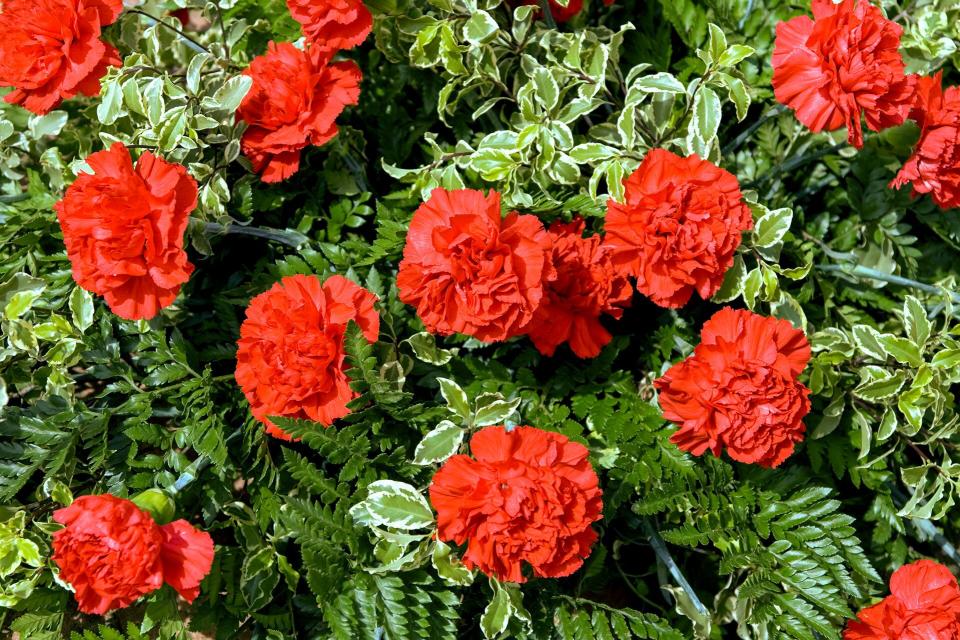Everything You Need to Know About Carnations

If you've been snubbing carnations in your gardens, containers, and fresh-cut arrangements because of their reputation as an ordinary bargain bloom, you've missed out. "The first thing that comes to mind for a lot of folks when they hear carnations is a generic flower that you always see from the store," says Chris Link of Plant Addicts. "But carnations are the second most popular cut flower—behind the rose—in the world for a reason: The plants are easy to care for, produce a lot of flowers, the flowers are quite beautiful—especially if left natural—and the flowers have a very strong and spicy fragrance."
Related: Your Ultimate Guide to Cultivating Gorgeous Roses

Getty Images
The History of Carnations
Carnations are part of genus dianthus, which comprises more than 300 species of flowers. Images and descriptions of dianthus flowers have appeared in recorded works for thousands of years, since botanist Theophrastus named the group by combining the words for divine ("dia") and flower ("antho") in ancient Greece. Dianthus flowers, which also include Sweet William, Maiden Pink, China Pink, and Garden Pink, are recognized for their pointed, zig-zag shape of their petals; the petals look like they've been trimmed with pinking shears, which may have inspired the group's common name, "pinks."
The iconic carnation blooms are Dianthus caryophyllus, also known as clove pinks. They're the birth flower associated with January, and a bloom famously tied to Mother's Day since the holiday's founder, Anna Jarvis, handed out carnations in honor of her own mother. (According to ProFlowers, "A red carnation today signifies respect of a living mother, while a white carnation is worn or given in honor of a mother who has died.") The flowers are widely grown in shades of pink, red, white, and yellow, and give off a strong scent. "Carnations are one of the most fragrant flowers we grow here at Floret, with a scent that reminds me of sugar and cloves," says farmer-florist Erin Benzakein. "Even a single stem of blooms will fill the entire room with a nostalgic fragrance. For a long time they'd had the reputation of a cheap supermarket flower, but because of their incredible vase life, numerous old-fashioned varieties, easy to grow nature, and incredible fragrance, they're quickly becoming a favorite flower for home gardeners."
How to Grow Carnations
To add carnations to your garden, choose a spot with full sun—at least six hours of direct light per day—and well-drained soil, says Link. "In general, you will want to propagate perennial carnations from cuttings and annual carnations from seeds," he explains. "You can easily divide mature plants, because these have shallow root systems but the roots are relatively tough." If you opt for seed, start growing the plants inside in late winter and move them outside after the last frost, says Benzakein.
Carnations will grow in the ground or in containers, says Link, blooming in about four to six weeks—depending on the variety you choose—with once-a-week watering. "It is always best to remember two things," he says. "First, the soil needs to drain well, both in the ground and in the container. Second, allow the soil to dry out completely between the times you water. It is always best to water deep and less often than providing some water more often," he says. Carnations can grow up to 30 inches high, so Benzakein uses a mesh grid netting to support the stems as they get taller.
Caring for and Arranging Cut Carnations
The ease of growing carnations in your own garden—plus the aesthetic diversity—makes them a versatile plant for arranging in your home. "They bloom all summer long from an early spring sowing, and their long stems and extremely long vase life make them an ideal flower for any type of arrangement," says Benzakein. Her favorites include the purple-edged Chabaud Benigna, flawless white Chabaud Jeanne Dionis, and coral-and-pink Chabaud Aurora.
To extend the life of your cut carnations, Link suggests snipping the stems at a 45-degree angle before arranging them in two or three inches of room temperature water; changing the water every two days (and trimming the stems each time); and placing them in a cool spot away from heating vents, cold drafts, or direct sunlight. He recommends the Fruit Punch variety, available in a range of juicy pink, reds, and mauve. "I really love these because of their strong fragrance and the fact that I can get mine to rebloom once or sometimes even twice," he says. "These are a great plant for both beginners and expert gardeners because these produce a ton of flowers with little effort or needed care besides watering."